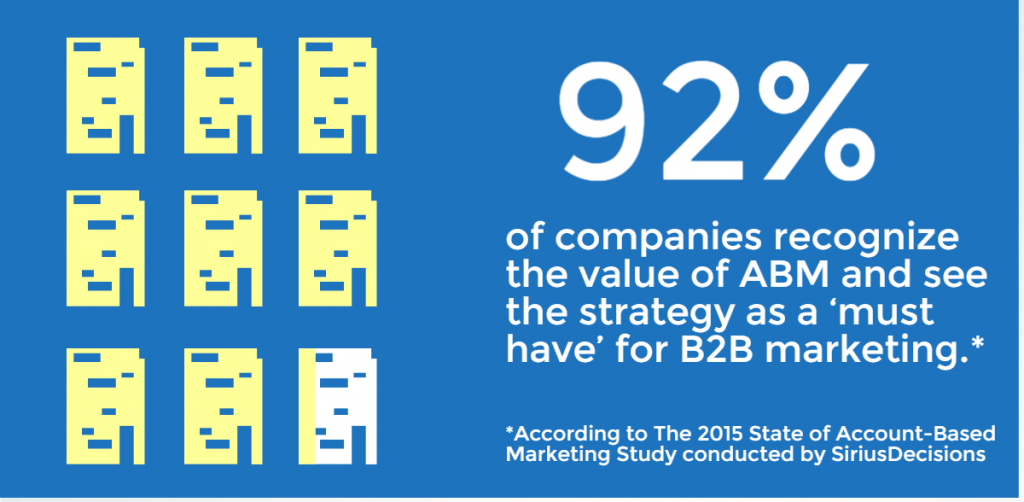By: Nate Vickery
Account-based marketing as a way of doing B2B marketing is generally considered a big boys’ game. If you read more than three sentences of any introduction to ABM, it is very likely you will read this type of marketing is for mid-sized businesses and big companies.
However, once you really start learning about ABM and mulling over it, it starts to dawn on you that there are definitely small businesses out there that might do pretty well by switching to account-based marketing. Thinking that every small B2B company should do ABM is a ridiculous proposition, but there are definitely SMBs that can benefit from this unique approach.
Account-Based Marketing 101
Before we can get into how content fits in with account-based marketing, it would probably be a good idea to say a few things about what ABM is.
In essence, account-based marketing is a type of B2B marketing where a company targets only one or few potential big clients and directs its marketing efforts specifically towards them. We are talking laser focus here, personalization on an entirely different level. You can find more definitions of ABM here.
One part of every (or at least the vast majority) ABM campaign will be the content produced specifically for this campaign which serves a very precise and clear-cut purpose.
The Basic Purpose of ABM Content
In account-based marketing, companies target only large leads whose accounts would replace a number of smaller ones. As a result of this, these potential clients are usually huge companies where decisions are not made by a single person. In fact, these companies will often have a dozen or even more decision-makers that all need to agree on an outside vendor, i.e. you.
The basic purpose of content is to play a supporting (often even more important) role in convincing all of these decision-makers that your company is their best choice. It is playing the same role as before and making the company more attractive, only the rules of the games are changed.
Changes to Game Rules
The most obvious difference between traditional marketing content and ABM content is the target audience. Traditionally, you attempt to reach as wide an audience as possible (in most cases), hoping to turn a sufficient number of them into customers. ABM content is produced with one or very few persons in mind, trying to predict what they need and would like to learn. Logically, this makes content marketing buyer personas far more important than is usually the case.
This type of precise targeting will also mean that far more content will need to be produced. For example, let’s imagine a company that has developed a piece of software that would do wonders for a player like eBay. This company’s ABM content team would probably need to produce different content for eBay’s CIO, CAO, CFO and every other member of their C-suite. With such big companies, you can always count on additional decision-makers like enterprise release managers and perhaps even HR folks.
The content for their CIO would probably be quite technical, focusing on issues that your piece of software might solve. The content for their CFO would be geared more towards money issues. HR decision-makers would get content that would speak about the problems employees often encounter and that your software might address.
This is a lot of content.
In addition to this, ABM content will need to be far more integrated with other marketing efforts, as well the rest of the organization so as to send a unison, harmonic message. Content creators or content marketing agency might need far more interaction with the development team (in the case of our hypothetical software vendor), people with sales and everyone else who is in any way involved.
This will require far more collaboration between the different people in a company, and this can, in fact, lead to unexpected and unrelated benefits for the company.
As you might have deduced yourself, ABM content will cost much more than traditional marketing content. Not only is the volume increased, but it will also need to be more elaborately planned and executed. For these same reasons, its creation will also require more time than usually.
The good news is that some of the content can always be repurposed or modified in order to be used on other accounts, especially since major companies often start to look like one another as part of their natural development.

Closing Word
If you have been thinking about ways in which you can go for the really big catch, then account-based marketing might just be the harpoon precise and powerful enough to reel it in.
When deciding on whether to give it a go, always keep in mind the certain requirements this type of marketing will have of your content creators.
Nate Vickery is a business consultant and a blogger. He is mostly engaged in tailoring internet marketing strategies for SMBs and startups. Nate is also an editor on Bizzmarkblog.com.



